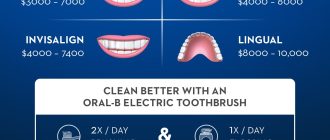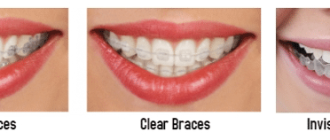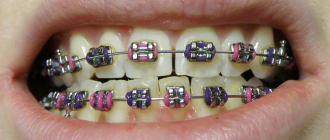Braces on the back of teeth are becoming more popular as patients seek to straighten their teeth without the conventional teenage metal braces look. These more aesthetically pleasing braces are also referred to as ‘lingual’ braces and common brand names include iBraces and Incognito. Linguals are much like the traditional bracket braces however they are placed on the lingual side or behind the teeth rather than being visible at the front.
They are made of metal brackets which are affixed to the back of the teeth and connected by stainless steel, nickel or titanium archwire, just like standard metal braces. They can also be customized with ceramic brackets to further conceal them when you yawn or widely open your mouth.
The appeal with this orthodontic alternative is that brackets on the back of teeth are virtually invisible or unnoticeable whilst talking or smiling. As expected, this convenience comes at a price. The costs associated with having braces placed on the back of the teeth means it’s a more expensive alternative to other teeth straightening options.
How Much Do Braces on Back of Teeth Cost?
Since these types of braces are more customized and require specialized training of the orthodontist, lingual braces can add substantial cost to the teeth straightening process. The average cost to have braces placed behind the teeth is approximately $10,000 to $12,000. They can add a whopping $1,500 to $3,000 in addition to having standard bracket braces or even Invisalign aligners. The cost is significantly higher than with other forms of teeth realignment treatments. The total quote should include bonding or cementing the brackets to the back of the teeth, orthodontic adjustment visits and also the retainer process, just like any other teeth straightening procedure.
Factors that Add to Lingual Braces Costs
The first and foremost component which enhances the costs of these types of braces is the orthodontist professional training which is required behind this work. Since the braces are placed behind the teeth, rather than at the front, orthodontists are required to undergo dedicated training in order to position teeth from this alternate angle. Essentially, the realignment process is reversed and accordingly more skill is needed to realign the teeth properly this way. The additional expertise required by orthodontists is passed on to the consumer as knowledge and expertise are always worth more and chargeable onto the client.
The second aspect which increases the cost of lingual braces is the treatment period takes longer to reach normal occlusion as opposed to traditional front braces. This means more visits being required to the dentist for adjustments and more check-ups to ensure the teeth are moving as anticipated and that they are being cleaned thoroughly during the process. You will be required to visit the orthodontist every two to three weeks. Further, the visits themselves take a longer period of time since adjustments are more involved than the few minute adjustment process with traditional braces.
Another component which adds to the cost of having this treatment is that the brackets used are created using CAD/CAM and rapid phototyping technologies. Newer technologies also allow for a new passive self-ligation design which dramatically reduces friction for greater patient comfort. The process of creating the brackets to begin with takes around six weeks. Once they are created, the orthodontist must cement them to the back of your teeth rather than having the convenient access at the front.
Do Braces on Back of Teeth Cost More than Invisalign?
Invisalign is another option for having braces made ‘invisible’. The clear plastic aligners provide enough discreetness and can therefore be just as cosmetically pleasing as having braces placed on the back of your teeth. It is another option which is often considered by potential braces patients when weighing up the costs and benefits of having inconspicuous braces.
Lingual braces are more expensive than Invisalign. However, there may be circumstances where Invisalign may not be appropriate for the patient. For example where the malocclusion is moderate or severe, Invisalign may not be a suitable product to use since it only assists with minor to mild teeth crowding or spacing.
On the other hand, Invisalign may be more appropriate than having braces on the back of teeth where the patient has an excessive overbite or where the teeth are particularly small. In these situations, lingual braces are not suitable and Invisalign may be the better and cheaper option.
Having braces placed on the back of your teeth can be more costly than Invisalign because the fixed brackets make it more difficult to brush the back of the teeth, whereas with Invisalign the plastic aligners can be removed allowing easy access for thorough teeth cleaning. The inability to clean the teeth properly results in plaque build-up. Consequently, the patient may end up with tooth decay or gingivitis which can add other associated dental costs.
Invisalign costs can escalate too, especially where realignment needs to be done at the end of the treatment or where aligners are lost or destroyed or where the patient has failed to wear the aligner for the required time. These factors can make Invisalign treatment significantly more expensive than initially quoted. The additional costs may even make the treatment end up costing the same or slightly more than having braces placed on the back of your teeth, even though the price of lingual braces is significantly higher than most other orthodontic treatment.
Are Back of Teeth Braces Worth the Cost?
The significant advantage with having braces fixed to the back of your teeth is your cosmetic appearance. If you don’t want people to notice that you have braces and are undergoing orthodontic treatment to have your teeth straightened then braces on the back of teeth is the most favorable option. The cost may especially be worth it if you are not a suitable candidate for Invisalign and your only other option is to get braces on placed at the front of the teeth.
Where your sole alternative is to buy traditional braces, you can reduce their visibility by purchasing ceramic brackets and wire which match the color of your teeth. However, the visibility or noticeability of having braces is still evident. This is why many patients opt for lingual braces in order to hide or conceal the brackets and wire altogether. This is especially important for professional personnel and also for self-esteem purposes when people are self-conscious of their image whilst undergoing such treatment.
Another aspect to consider when weighing up the costs of braces on the back of teeth is the additional time the process involves. In addition to having braces affixed for a longer period, you will be required to visit the orthodontist’s office more times and for a lengthier duration each visit. Weighing up whether your time is expendable depends on your personal circumstances. For example where you are unable to get paid leave from work, this can also add to the cost of having braces on the back of teeth may not be an acceptable expenditure for you. In many situations patients do opt for the longer treatment in order to hide the braces.
Should I Pay the Extra Cost of Braces on Back of Teeth?
Although lingual braces are mostly invisible, you still will be able to notice their existence from certain angles. For example when you yawn or open your mouth wide enough people may be able to see that you have the braces. Even so, they are much more attractive than the traditional set of brackets and metal in your mouth.
Having braces on the back of your teeth requires specialized training from the orthodontist and their skill is often recompensed with higher fees and charges. However, if you can afford the additional costs of having lingual braces then you may even consider the extra months of treatment worthwhile.
In paying for braces to be placed behind the teeth, there are various options for financing including your orthodontist offering in office payment plans, dental health insurance and health care lines of credit. Whilst insurance plans may not cover the whole cost of lingual braces, some of the cost may be covered which will help reduce the overall treatment price for you. Lingual braces are unlikely to be covered by government programs such as Medicaid or by pro bono programs for children since they are a luxury option for having orthodontic treatment. If you are concerned about your appearance and self-esteem then looking into having back of teeth braces is an advisable consideration for you.






